[Ring . . . ring . . . ring]
You: Hello?
Operator: I have a long-distance collect call from this date sixty-six years ago. Will you accept the charge?
You: Okay.
Yes, on this date in 1956, April Fools’ Day was April Phones’ Day. That’s the day many telephone numbers in Fort Worth and Arlington changed to accommodate long-distance calling.

Note that for some telephone numbers only the prefix (the name of the exchange) and its two-letter abbreviation changed (for example, CEdar 8 to BElmont 8). For other telephone numbers a digit was added after the exchange prefix. But for still other telephone numbers the name of the exchange and its two-letter abbreviation changed, and a digit was added, thus changing the telephone numbers from six to seven digits. For example, LInden, LAmar, and LOckwood became JEfferson 4, JEfferson 5, and JEfferson 6.
No foolin’.
In Poly, I remember, our family telephone number changed overnight from LO 2801 to JE 6-2801.
We were discombobulated for days.
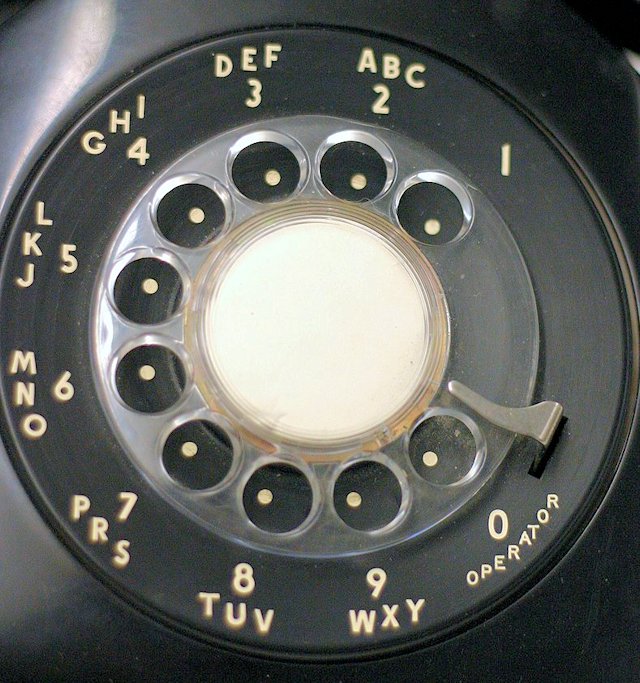 The two digits of the new exchange names were dialed the same as the two digits of the old exchange names—by the same finger hole on the dial.
The two digits of the new exchange names were dialed the same as the two digits of the old exchange names—by the same finger hole on the dial.
Now let’s dial back the years for some even earlier telephone exchange history:
Fort Worth’s first telephones were installed by 1881.
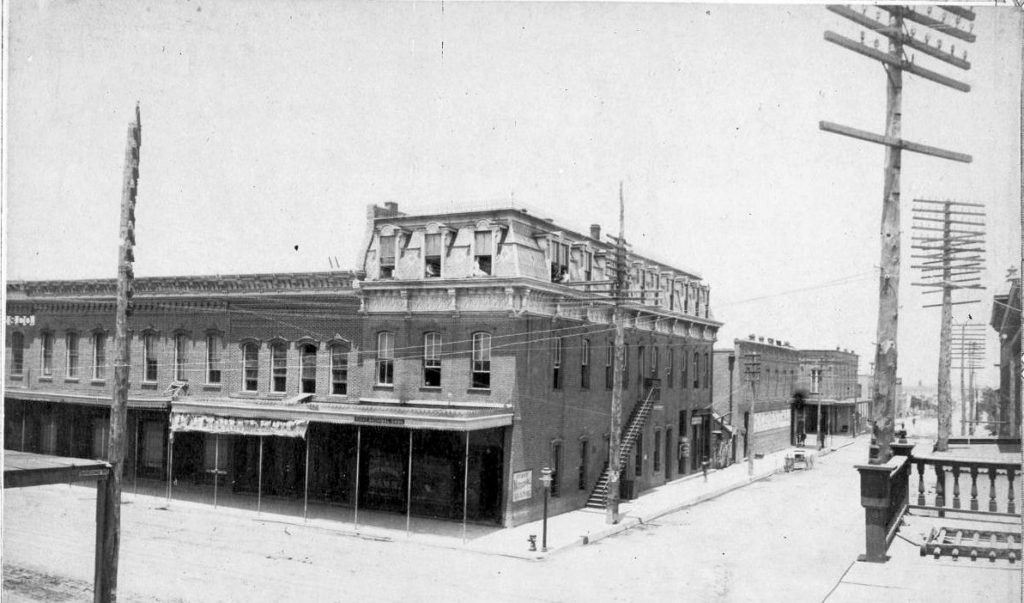 The first telephone exchange was located on the third floor of the First National Bank building at 215 Houston Street. In this photo of 1881 note the wire-laden telephone poles on the right. And if you squint you can see women sitting in windows on the third floor. Perhaps they were “hello girls,” as female operators were called (men were considered too rude to be operators). In 1890 this exchange would be the workplace of “hello girl” Addie Cullen, whose marriage to Mayor William S. Pendleton would lead to scandal and his resignation. (Photo from University of Texas at Arlington Library.)
The first telephone exchange was located on the third floor of the First National Bank building at 215 Houston Street. In this photo of 1881 note the wire-laden telephone poles on the right. And if you squint you can see women sitting in windows on the third floor. Perhaps they were “hello girls,” as female operators were called (men were considered too rude to be operators). In 1890 this exchange would be the workplace of “hello girl” Addie Cullen, whose marriage to Mayor William S. Pendleton would lead to scandal and his resignation. (Photo from University of Texas at Arlington Library.)
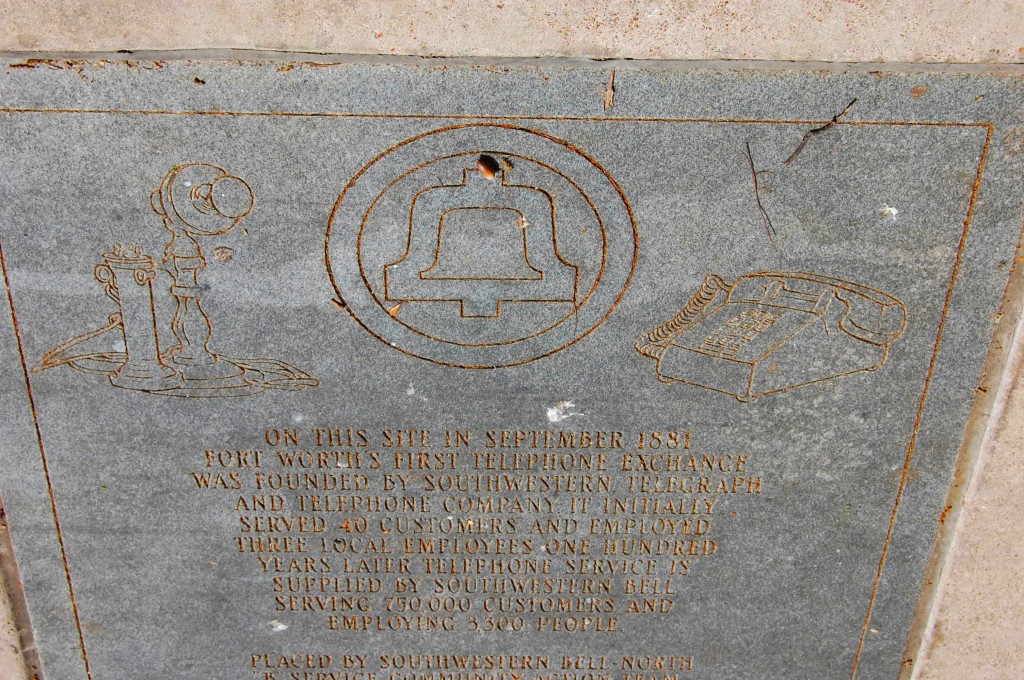 A plaque set in the sidewalk marks the location of the first telephone exchange, which initially served forty customers.
A plaque set in the sidewalk marks the location of the first telephone exchange, which initially served forty customers.
A single switchboard, a handful of “hello girls,” and phone numbers of first one digit and then two and three and four digits served the city for thirty years.
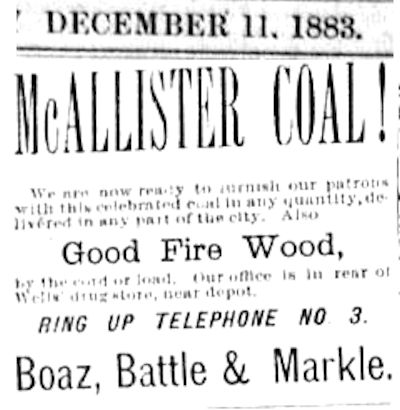 Telephone numbers in newspaper advertisements first appeared in 1883.
Telephone numbers in newspaper advertisements first appeared in 1883.
But during those first thirty years Fort Worth’s population exploded. In fact, in 1900 Fort Worth’s population was just 26,688. By 1910 the population was 73,312, an increase of almost threefold. Much of that increase came in 1909 when Fort Worth annexed the city of North Fort Worth, which had boomed after the packing plants began operation in 1903. The increase in the number of phones in Fort Worth was almost ninefold, from 1,116 in 1900 to 9,800 in 1910. Thus, in 1900 one person in twenty-three had a telephone; by 1910 one person in seven had a telephone.
 In fact, it was in large part due to the population boom in the former city of North Fort Worth that Southwestern Telegraph and Telephone Company in 1910 was forced to make some changes. A single switchboard could handle only so many phone numbers. So, the Prospect exchange was added to serve the North Side. Also, on January 23 the Star-Telegram announced (type is cut off on the right margin in this clip) that, beginning on January 29, to place a telephone call a caller would have to specify—vocally—to the operator whether the number desired was in the Lamar exchange or the Prospect exchange. The original single exchange that had served all of the city to that point had not had a name/prefix. Now it became the “Lamar” exchange to distinguish it from the Prospect exchange. And the news story said that soon a third exchange—Rosedale—would be opened for the South Side.
In fact, it was in large part due to the population boom in the former city of North Fort Worth that Southwestern Telegraph and Telephone Company in 1910 was forced to make some changes. A single switchboard could handle only so many phone numbers. So, the Prospect exchange was added to serve the North Side. Also, on January 23 the Star-Telegram announced (type is cut off on the right margin in this clip) that, beginning on January 29, to place a telephone call a caller would have to specify—vocally—to the operator whether the number desired was in the Lamar exchange or the Prospect exchange. The original single exchange that had served all of the city to that point had not had a name/prefix. Now it became the “Lamar” exchange to distinguish it from the Prospect exchange. And the news story said that soon a third exchange—Rosedale—would be opened for the South Side.
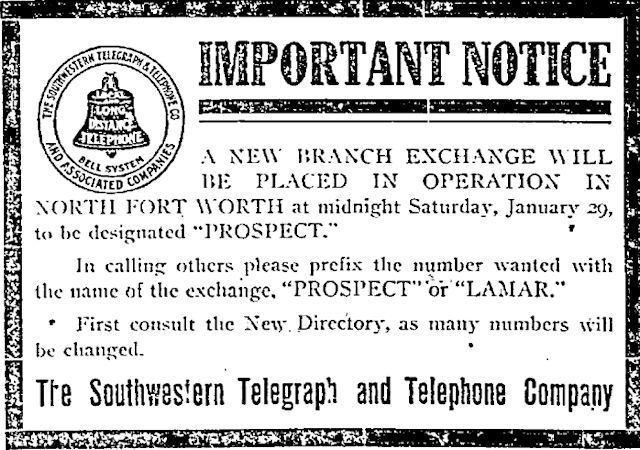 Clip is from January 28.
Clip is from January 28.
 On August 8, 1909 the Star-Telegram printed this photo of the new Cobden Building on North Main Street, which would house the new Prospect telephone exchange in 1910.
On August 8, 1909 the Star-Telegram printed this photo of the new Cobden Building on North Main Street, which would house the new Prospect telephone exchange in 1910.
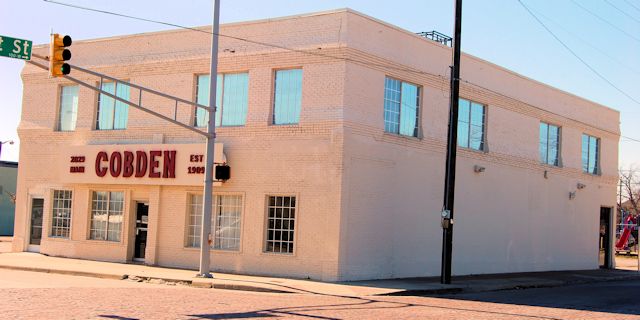
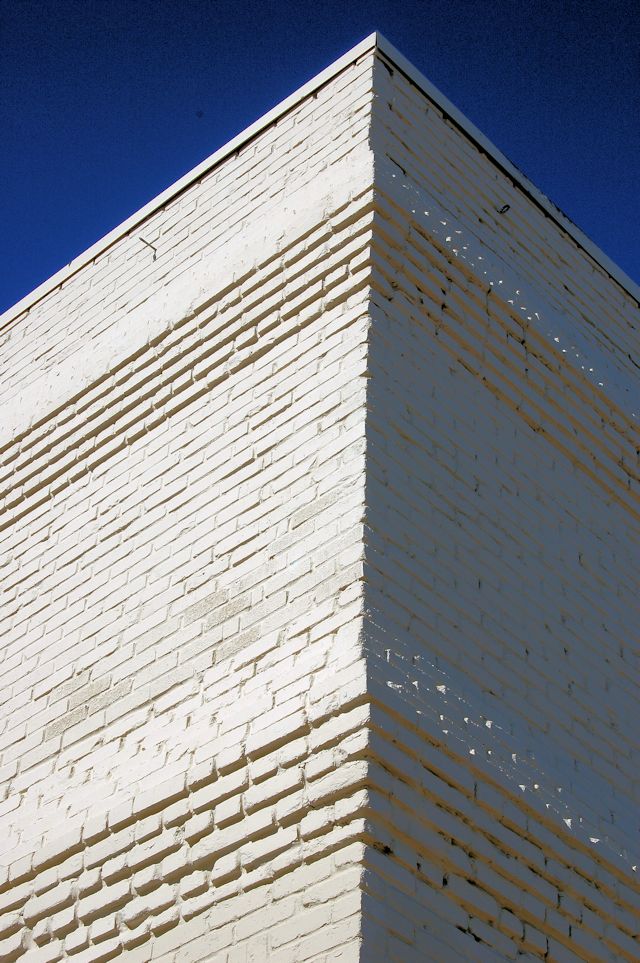 The Cobden Building today at 2027 North Main Street.
The Cobden Building today at 2027 North Main Street.
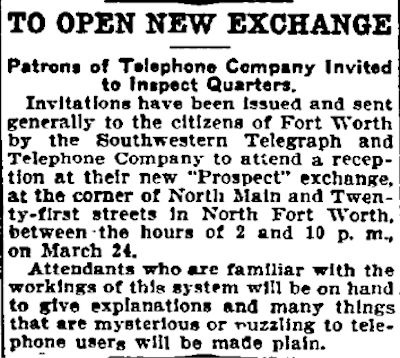 The phone company held an open house for the new Prospect exchange on March 24, 1910. Clip is from the March 23 Star-Telegram.
The phone company held an open house for the new Prospect exchange on March 24, 1910. Clip is from the March 23 Star-Telegram.
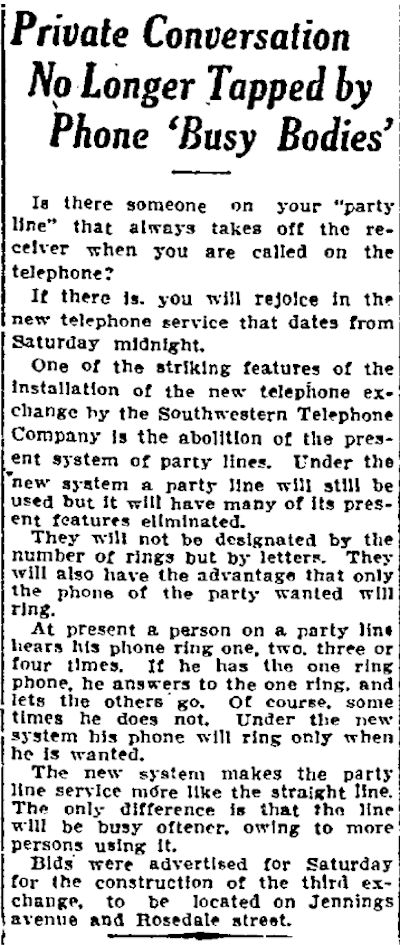 On January 29, 1910 the Star-Telegram reported that the new phone system would change the nature of telephone party lines. Now, instead of each phone on a party line being assigned a different number of rings, each phone would be assigned a different letter. Also, “only the phone of the party wanted”—not all the phones on the party line—“will ring.”
On January 29, 1910 the Star-Telegram reported that the new phone system would change the nature of telephone party lines. Now, instead of each phone on a party line being assigned a different number of rings, each phone would be assigned a different letter. Also, “only the phone of the party wanted”—not all the phones on the party line—“will ring.”
The story also said that bids would be taken for construction of the third exchange (Rosedale) building on Jennings Avenue.
 Indeed, on April 7 the Dallas Morning News reported on the progress of construction of the $40,000 ($985,000 today) Rosedale exchange building.
Indeed, on April 7 the Dallas Morning News reported on the progress of construction of the $40,000 ($985,000 today) Rosedale exchange building.
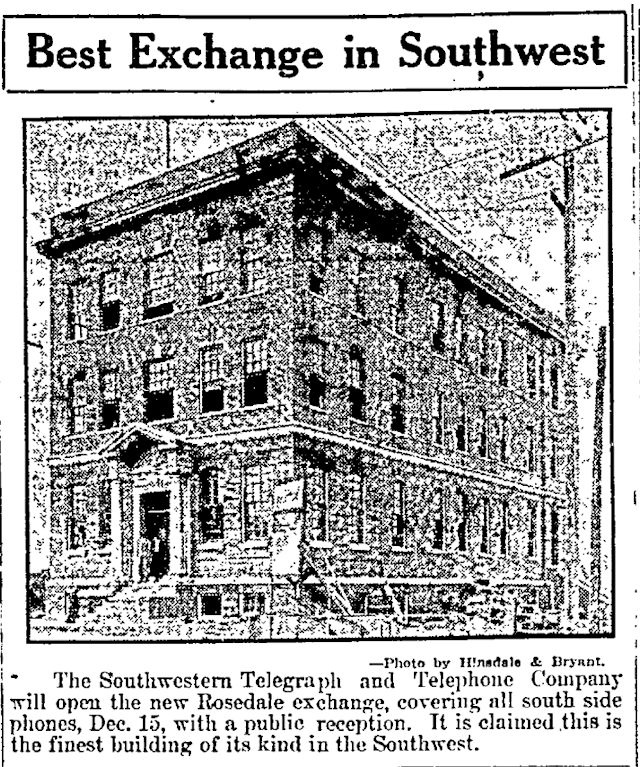 On October 2 the Star-Telegram printed a photo of the new Rosedale exchange building.
On October 2 the Star-Telegram printed a photo of the new Rosedale exchange building.
 On December 31, 1910 the Star-Telegram announced that the Rosedale exchange would begin operation with thirty “hello” girls.
On December 31, 1910 the Star-Telegram announced that the Rosedale exchange would begin operation with thirty “hello” girls.
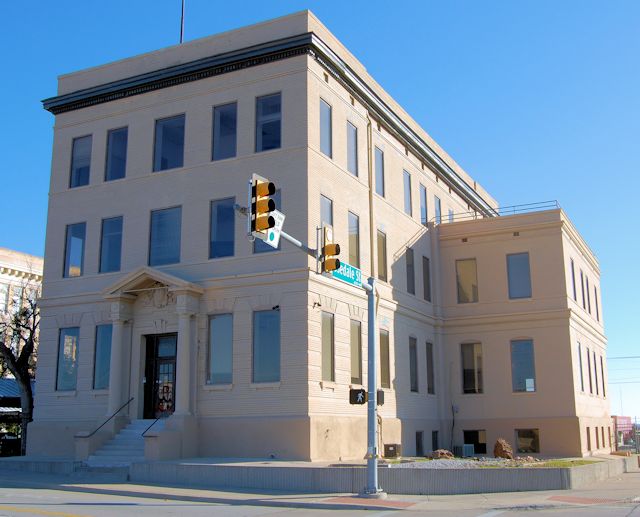
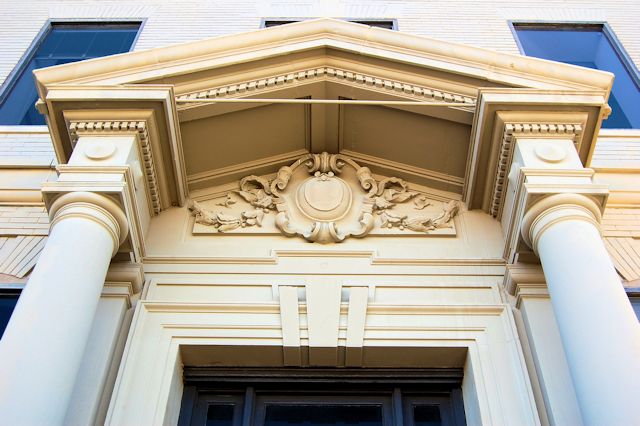 The Rosedale exchange building today.
The Rosedale exchange building today.
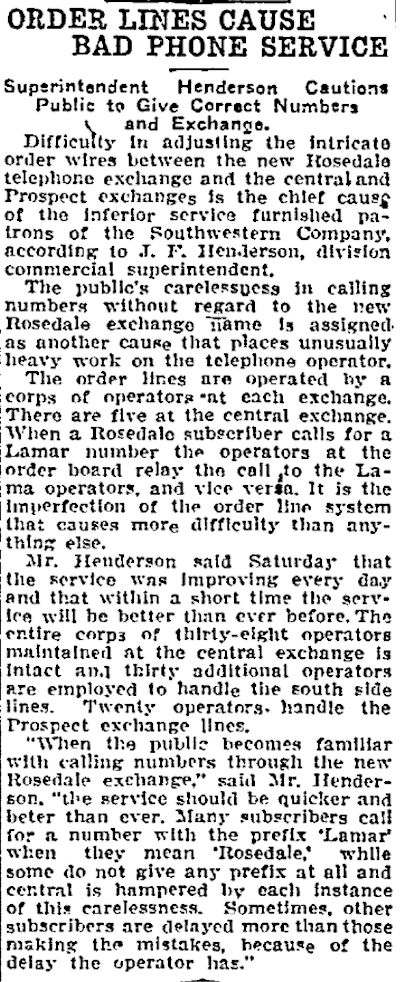 Predictably, there were growing pains as callers adjusted to having to specify one of not two but now three exchanges when they placed a call with an operator. Clip is from the January 7, 1911 Star-Telegram.
Predictably, there were growing pains as callers adjusted to having to specify one of not two but now three exchanges when they placed a call with an operator. Clip is from the January 7, 1911 Star-Telegram.
 In 1910 the phone company was located where it is located today: on Throckmorton at West 10th Street near Peter Smith Park and St. Patrick Cathedral. (Top photo from Greater Fort Worth, 1907.)
In 1910 the phone company was located where it is located today: on Throckmorton at West 10th Street near Peter Smith Park and St. Patrick Cathedral. (Top photo from Greater Fort Worth, 1907.)
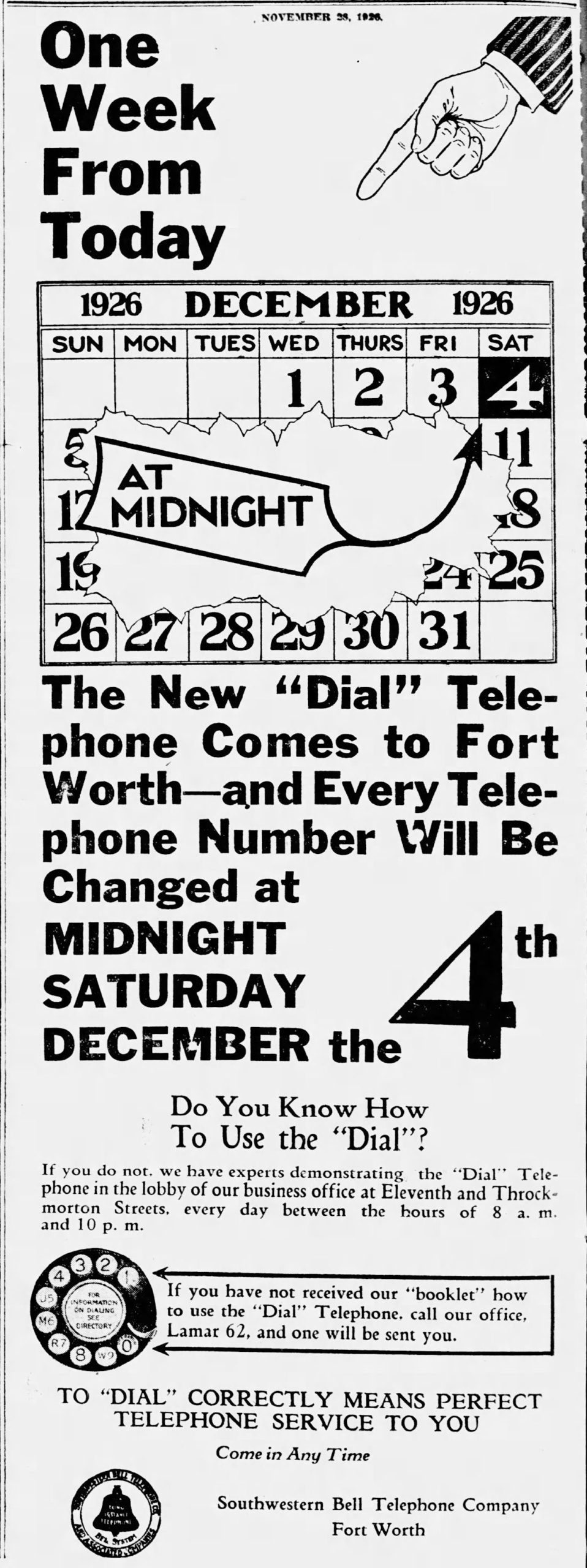 Speed-dial to 1926. That’s when the direct-dial system began. The word dial was so new that this Bell ad placed the word in parentheses. Don’t know how to “dial”? Experts in the lobby of the telephone company business office would show you how. Be sure to bring your fingers.
Speed-dial to 1926. That’s when the direct-dial system began. The word dial was so new that this Bell ad placed the word in parentheses. Don’t know how to “dial”? Experts in the lobby of the telephone company business office would show you how. Be sure to bring your fingers.
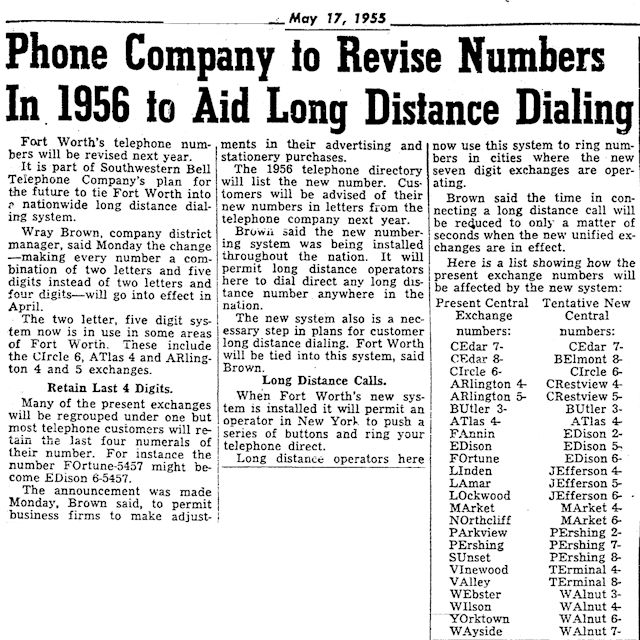
Fast-forward thirty years. Then came the aforementioned 1956, when the two-letter abbreviations for several exchanges were changed, and phone numbers changed from six to seven digits to accommodate long-distance dialing.
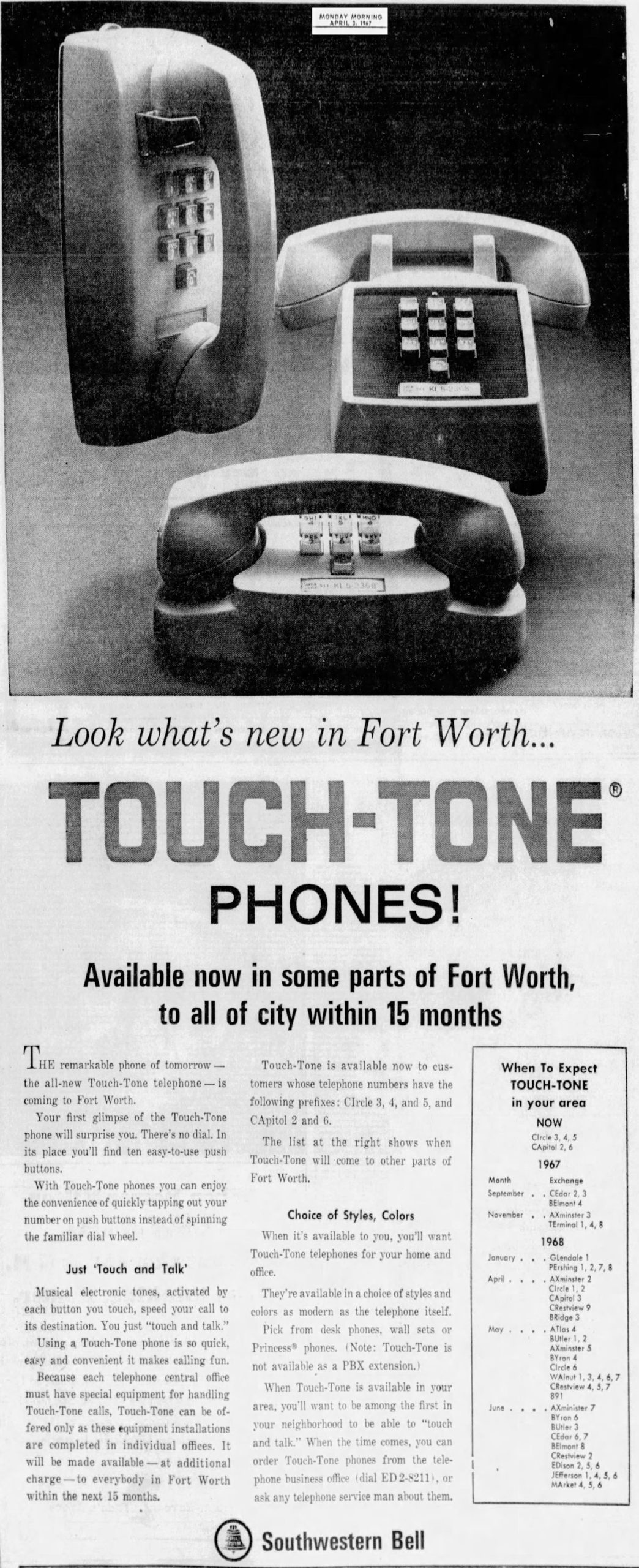 In 1967 touch-tone “dialing” came to Cowtown (in certain areas).
In 1967 touch-tone “dialing” came to Cowtown (in certain areas).
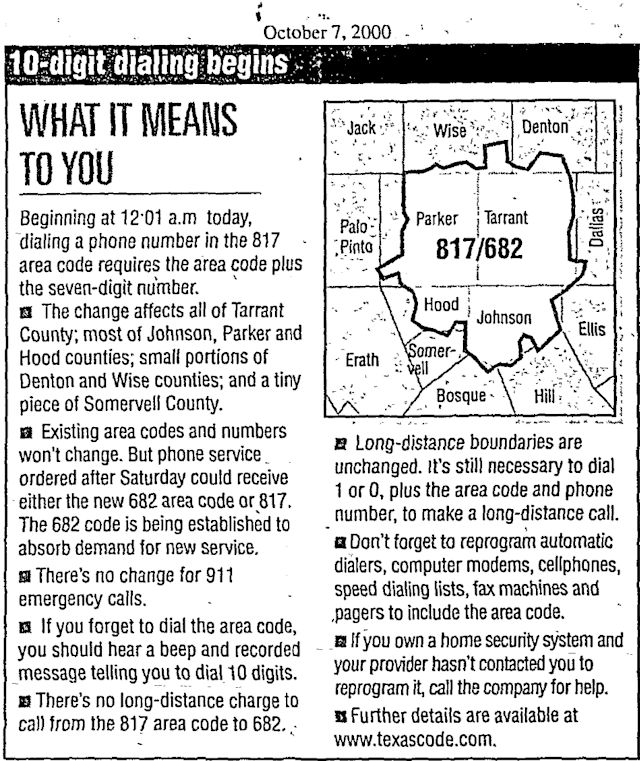 Phone numbers grew to ten digits in 2000 when the area code 817 became required for all local calls.
Phone numbers grew to ten digits in 2000 when the area code 817 became required for all local calls.
In the twenty-first century, here’s a look at other surviving telephone exchange buildings from the twentieth century:

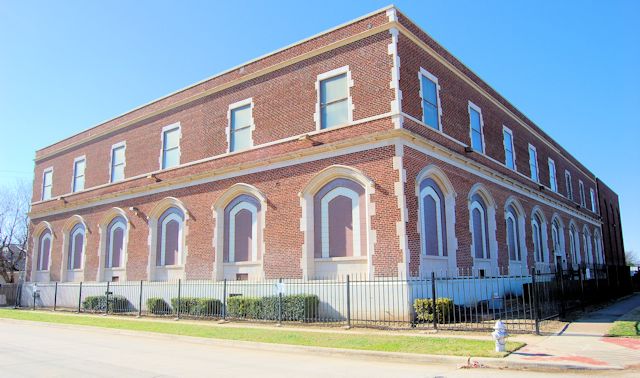
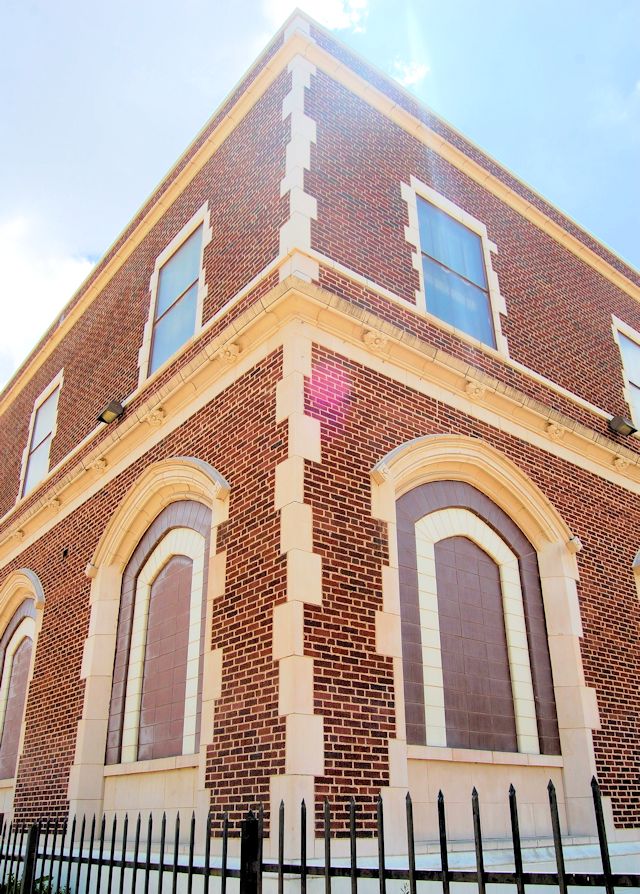
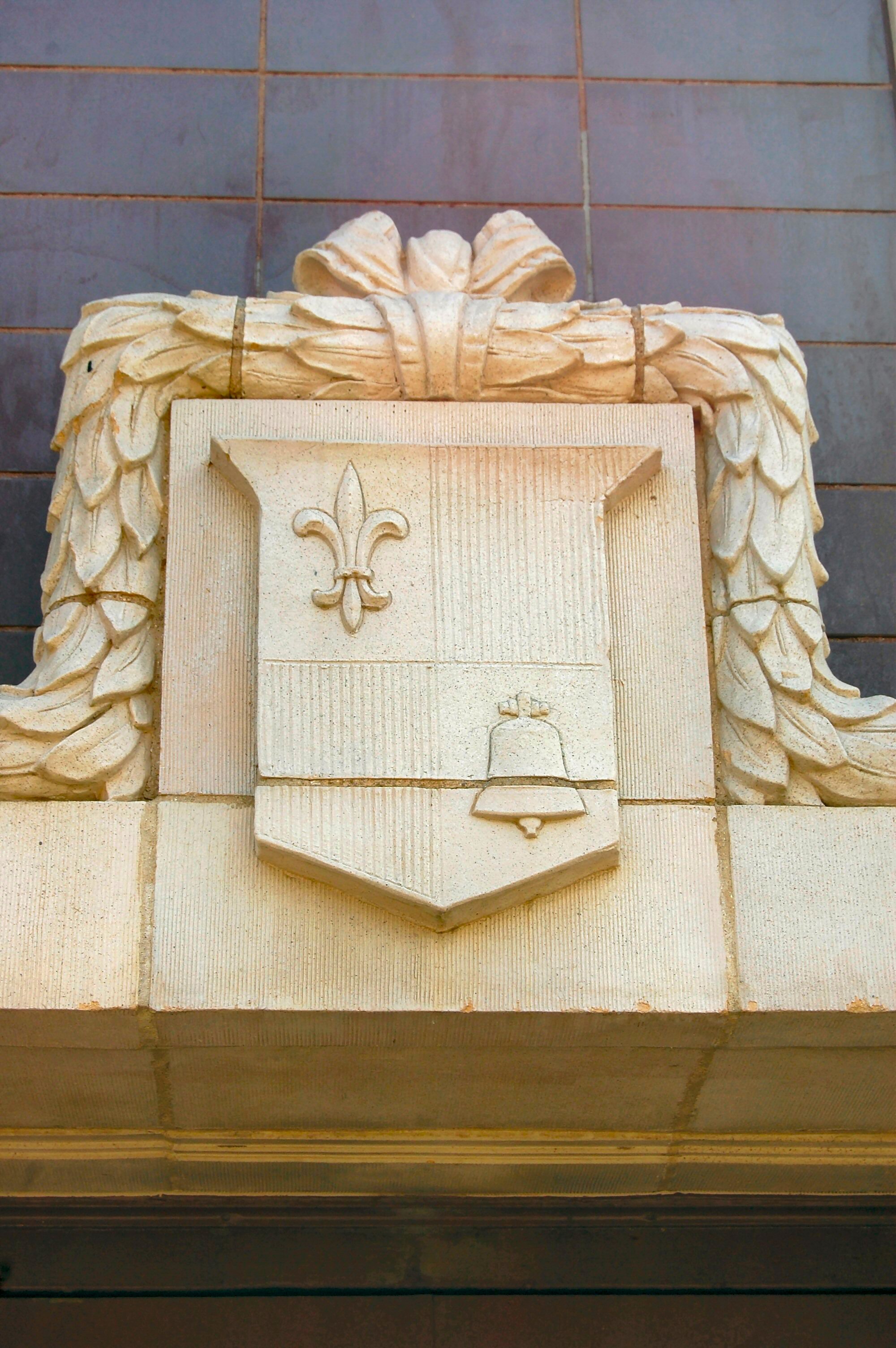
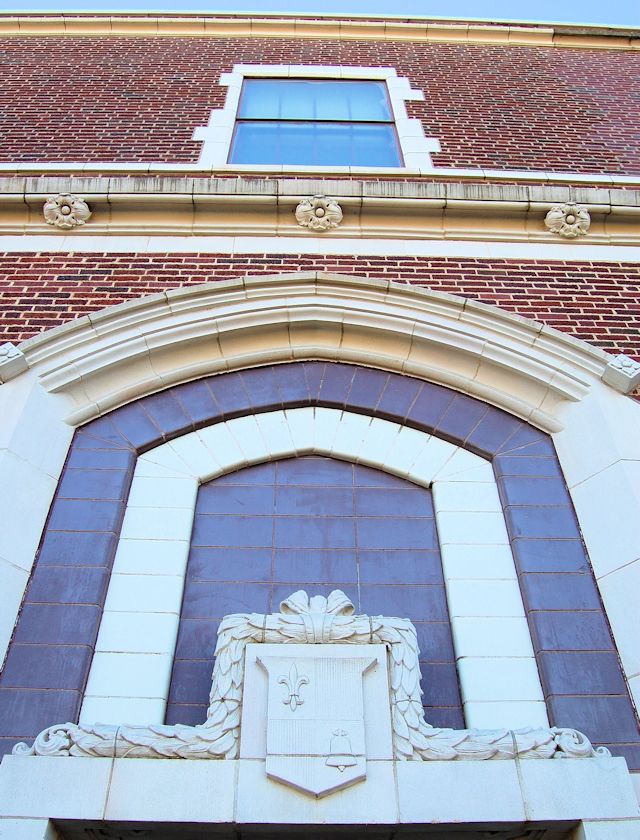 JEfferson on Avenue G (1927) just off Vaughn Boulevard in Poly. When the exchange building opened in 1927 it allowed sixteen hundred telephone customers to switch from manual (operator-placed) dialing to direct dialing.
JEfferson on Avenue G (1927) just off Vaughn Boulevard in Poly. When the exchange building opened in 1927 it allowed sixteen hundred telephone customers to switch from manual (operator-placed) dialing to direct dialing.
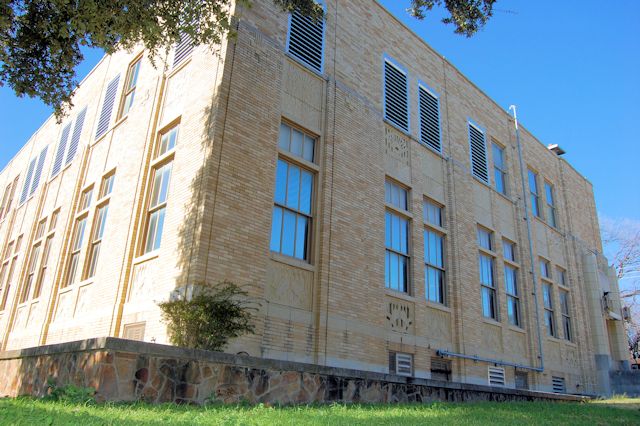
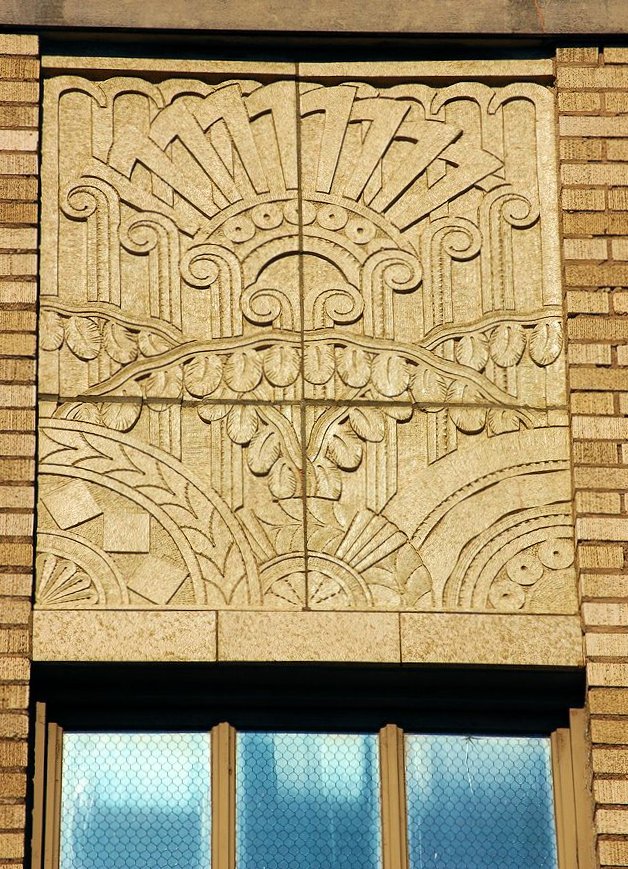
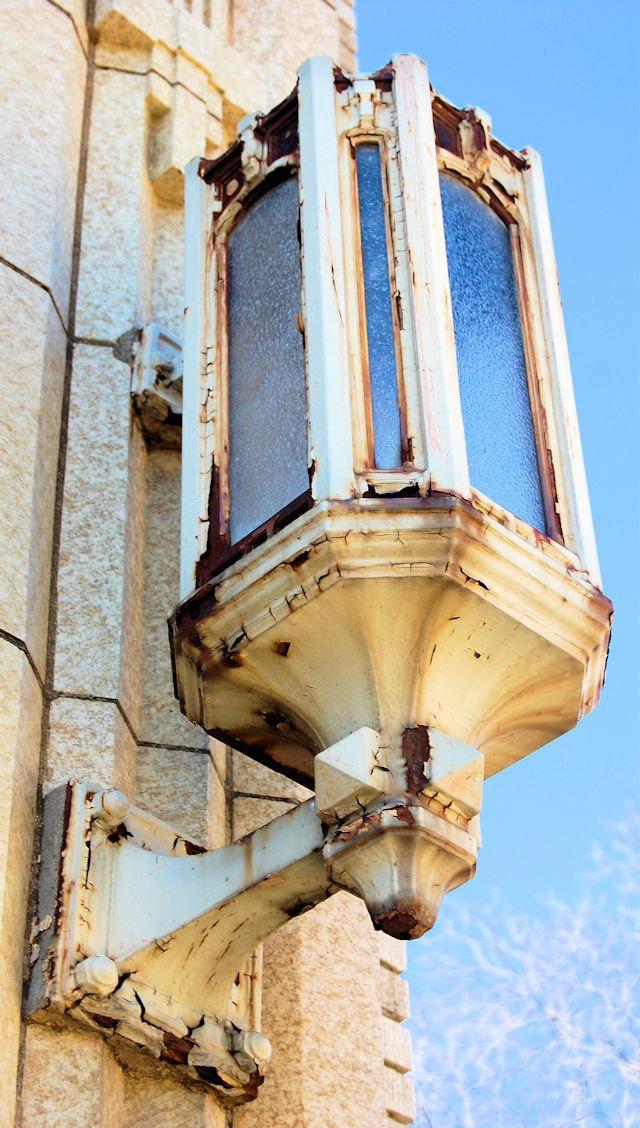
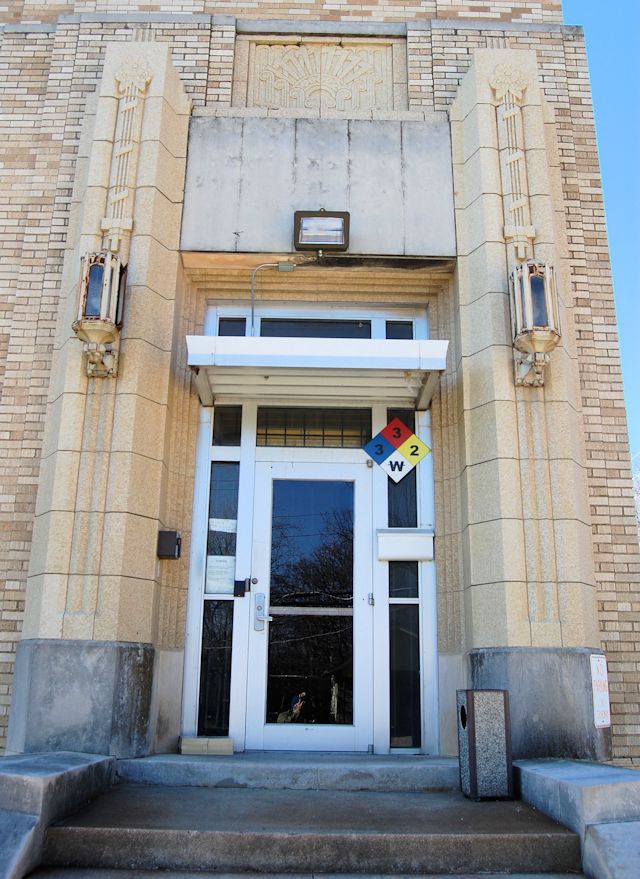
 PErshing on Pershing Avenue (1931) on the West Side.
PErshing on Pershing Avenue (1931) on the West Side.
 This 1931 ad announcing the opening of the new “7” exchange building on Pershing Avenue shows the growing pains that Fort Worth endured each time an exchange was added.
This 1931 ad announcing the opening of the new “7” exchange building on Pershing Avenue shows the growing pains that Fort Worth endured each time an exchange was added.
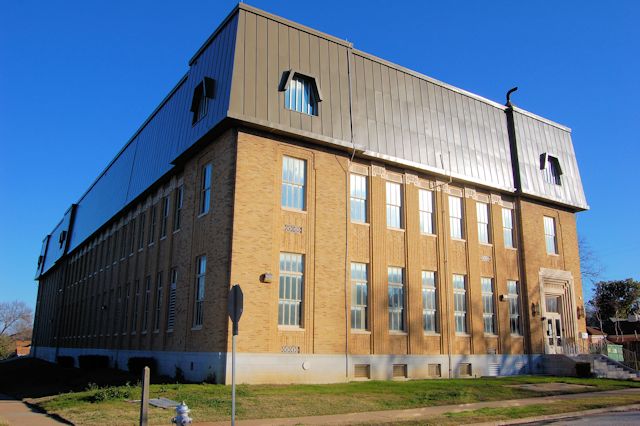
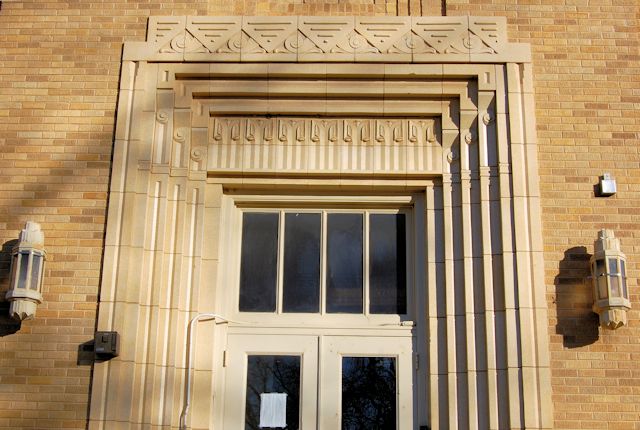 WAlnut on West Bowie Street (1931) on the South Side.
WAlnut on West Bowie Street (1931) on the South Side.
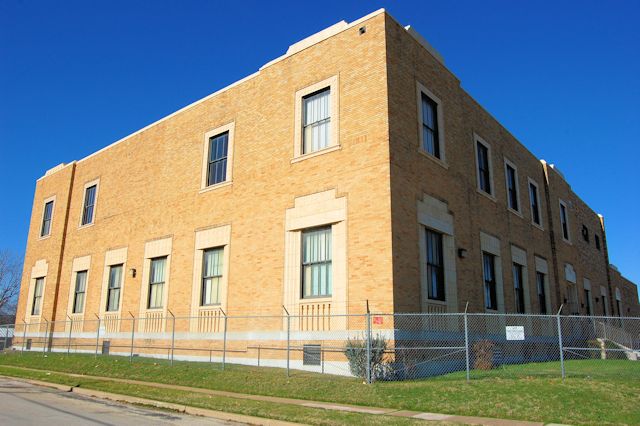
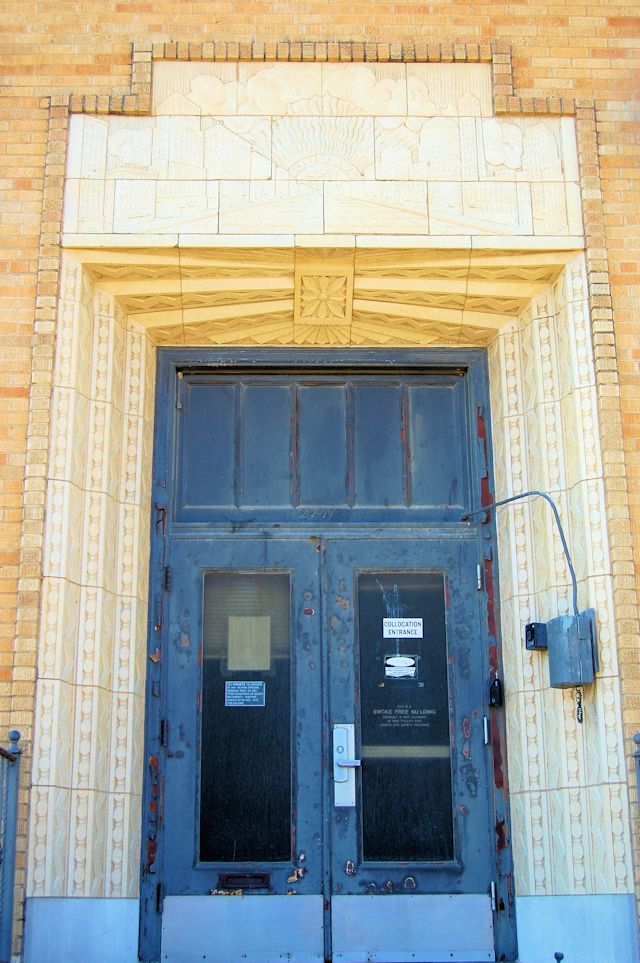

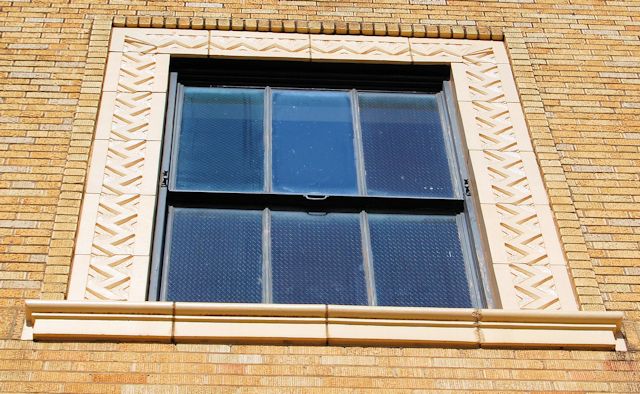
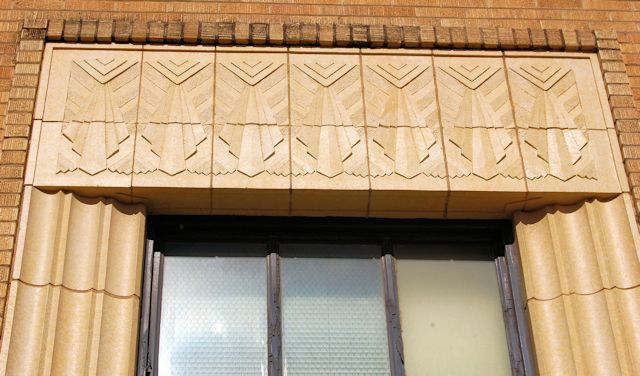 MArket on Chestnut Avenue (1931) on the North Side.
MArket on Chestnut Avenue (1931) on the North Side.
Note the art deco detailing of the three exchanges built in the early 1930s.
And finally:
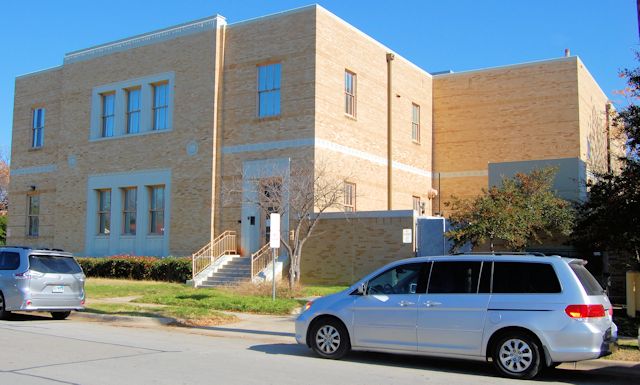
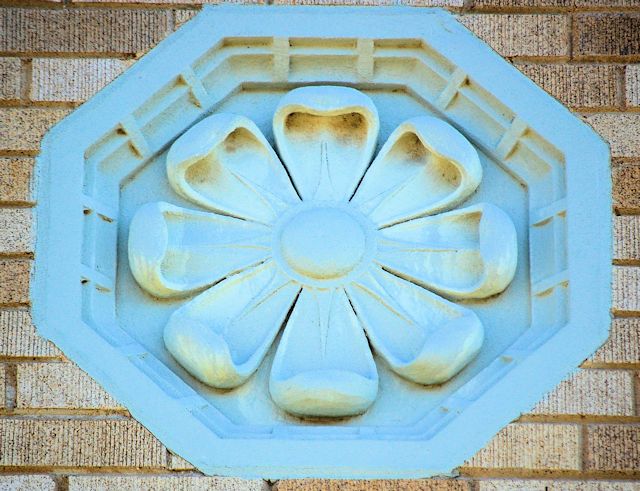
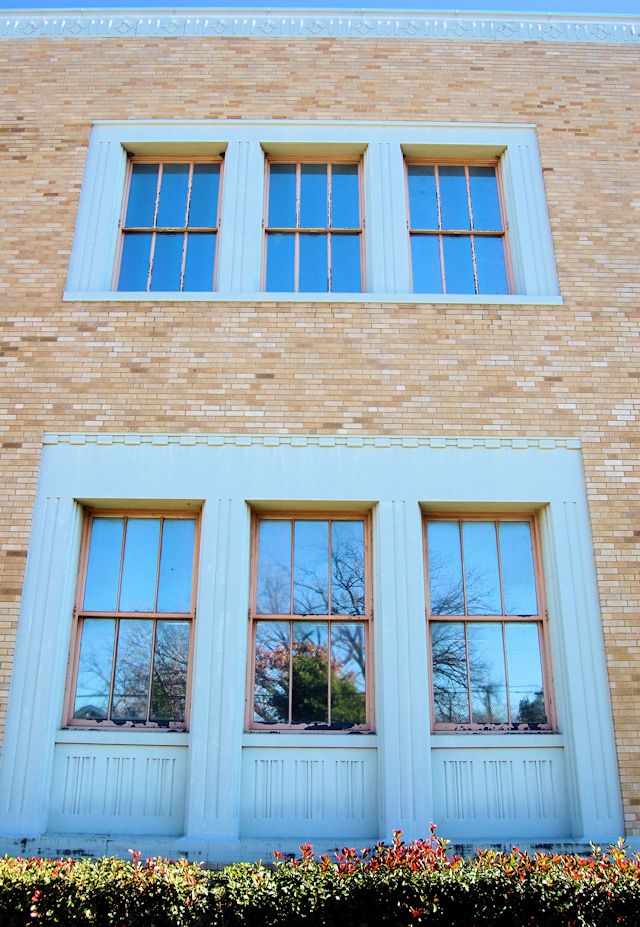 VAlley on Eagle Drive (1946) in Riverside.
VAlley on Eagle Drive (1946) in Riverside.
I’ll hang up now.






Thanks! I recently acquired a very old PBX switchboard and am in process of restoring it and learning more about its history. It came from the All Saints Episcopal Hospital Ft Worth, and I am going to getting info on who was the original operator! Anyone have any info on when or how this switchboard got there? Interesting piece of history!
Great story!! I never understood how those exchanges were determined. I grew up in Arlington, so ours was CR4- and I will always remember the rest of it too! Loved the rotary phones and didn’t want to get a touch tone. Now I can’t imagine life without the cell.
Thanks. And to think that it took all those phone exchange buildings put together to do what one switchboard did in the beginning.
Bellissimo! You made the right call in writing this feature.
I had a pun-sniffing dog read your comment before I read it. Darned dog trotted right past “Bellissimo,” and it exploded right in my face. Back to training school, Rover.
The list of exchanges identifying what became JEfferson is good to see….I had heard of the LInden and LOckwood numbers (we were LAmar), but I couldn’t visualize where they were….Interesting that they were not (to my recollection) particularly geographic….GPs on Avenue L were LInden; family friends on Avenue J were LOckwood….next door was also LOckwood….
You were Lamar! That surprises me. Lamar was usually the center of town. And I do not recall Linden. (Millennials reading this won’t understand a word of it.)
What a great story, Mike. My mother worked at the Jefferson exchange in the 1950s. She loved it. She got laid off with the big switch to direct dial. Now, of course, all that fiber optic cable, microwave, and satellite stuff. First your call goes to the NSA, then CIA, then the FBI, then your caller. I recall the old party lines. In the 50s thru early 70s a private line cost more. When I moved back to Poly in 1977 the old woman across the alley from me had shared that line forever. She held out till I got my private line, thus giving her a private line by default. At the lower price of a party line. Keep up the good work, Mike.
Thanks, Earl. A century ago that now-primitive technology was as cutting edge as smartphones and “apps” are today.
Shame about that mansard bit on the South Side exchange. We visited it when we lived on the south side and the details are wonderful.
I had to reshoot that one because the roof is a fairly recent addition. Still a lovely building for its function. But the PErshing is my favorite.
Thanks for this great research, photos, and info! I lived through a bunch of this! 🙂
Thanks, Kay. It was fun to learn about the history of the exchange system in Fort Worth and to find the surviving exchange buildings.